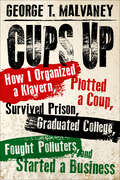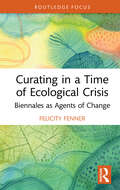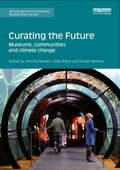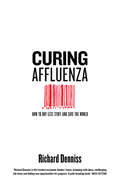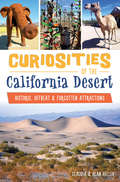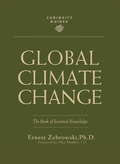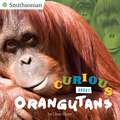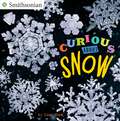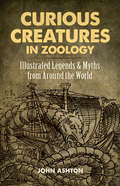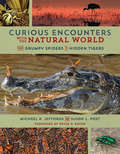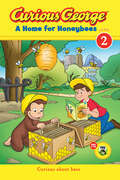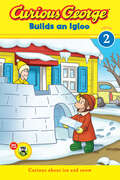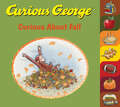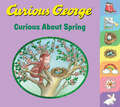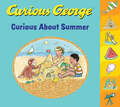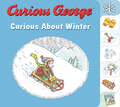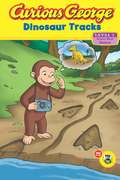- Table View
- List View
Cups Up: How I Organized a Klavern, Plotted a Coup, Survived Prison, Graduated College, Fought Polluters, and Started a Business (Willie Morris Books in Memoir and Biography)
by George T. MalvaneyGeorge T. Malvaney's life epitomizes the old maxim that "You cannot make this stuff up." Combine a young Klansman from Mississippi, an armed coup attempt in the Caribbean, a stay in prison, and a life-changing epiphany, and you have but half of this swashbuckling tale. Throw in the worst man-made ecological disaster in the history of the United States, and you have unleashed Malvaney's full life story. The Klansman, the soldier of fortune, the wild-eyed prisoner transforms into a renowned leader of the Mississippi Gulf Coast cleanup effort in the wake of the BP Deepwater Horizon oil spill.In his too-crazy-not-to-be-true memoir, Malvaney chronicles what easily should be several lifetimes of adventure--and misadventure. Growing up in a close-knit family in Jackson, Mississippi, the young Malvaney preferred woods and swamps to the drudgery of high school. He dropped out, enlisted in the Navy, and shortly afterwards joined the Ku Klux Klan. While onboard, he organized a branch of the Klan, corrupting and endangering his crewmen. After his discharge, he answered a mercenary call to take part in an invasion of Dominica, a Caribbean fiasco known as the "Bayou of Pigs." That madness landed him in a federal penitentiary. And there, somehow, he vowed to turn his life around.Cups Up, a title drawn from the wake-up call shouted at prisoners, is a story of perseverance, cleansing, and redemption. It chronicles the roller coaster life of a high school dropout, ex-Klansman, ex-mercenary, ex-felon, and ex-con, who went on to become a college graduate, a hardnosed environmental regulator, and a widely respected top executive in a company with more than a thousand employees.
Curating in a Time of Ecological Crisis: Biennales as Agents of Change
by Felicity FennerCurating in a Time of Ecological Crisis reaffirms the relevance and impactful role of art, revealing how contemporary art exhibitions can capture the zeitgeist and advance new and collaborative approaches to a more sustainable inhabitation of Earth. The book is largely focused on biennales, which it argues are the contemporary exhibition models with the greatest capacity to offer new perspectives and propose alternative ways of connecting with our social and natural environments. Felicity Fenner demonstrates this by showing how curators of these high-profile exhibitions are responding in creative and engaging ways to the issues that preoccupy artists and society more broadly, of which the ecological crisis is paramount. Drawing on case studies from different parts of the world, the author reveals how biennales can make a constructive contribution to debates and attitudes around climate change, and how the role of the curator has evolved to re-embrace a duty of care not just to art but to the natural world as well. Curating in a Time of Ecological Crisis investigates how large-scale exhibitions of contemporary international art can become agents of change. As such, the book will be essential reading for scholars, students, and practitioners with an interest in exhibitions, curating, contemporary art, and environmental sustainability.
Curating the Future: Museums, Communities and Climate Change (Routledge Environmental Humanities)
by Libby Robin Jennifer Newell Kirsten WehnerCurating the Future: Museums, Communities and Climate Change explores the way museums tackle the broad global issue of climate change. It explores the power of real objects and collections to stir hearts and minds, to engage communities affected by change. Museums work through exhibitions, events, and specific collection projects to reach different communities in different ways. The book emphasises the moral responsibilities of museums to address climate change, not just by communicating science but also by enabling people already affected by changes to find their own ways of living with global warming. There are museums of natural history, of art and of social history. The focus of this book is the museum communities, like those in the Pacific, who have to find new ways to express their culture in a new place. The book considers how collections in museums might help future generations stay in touch with their culture, even where they have left their place. It asks what should the people of the present be collecting for museums in a climate-changed future? The book is rich with practical museum experience and detailed projects, as well as critical and philosophical analyses about where a museum can intervene to speak to this great conundrum of our times. Curating the Future is essential reading for all those working in museums and grappling with how to talk about climate change. It also has academic applications in courses of museology and museum studies, cultural studies, heritage studies, digital humanities, design, anthropology, and environmental humanities.
Curating the Future: Museums, Communities and Climate Change (Routledge Environmental Humanities)
by Libby Robin Jennifer Newell Kirsten WehnerCurating the Future: Museums, Communities and Climate Change explores the way museums tackle the broad global issue of climate change. It explores the power of real objects and collections to stir hearts and minds, to engage communities affected by change. Museums work through exhibitions, events, and specific collection projects to reach different communities in different ways. The book emphasises the moral responsibilities of museums to address climate change, not just by communicating science but also by enabling people already affected by changes to find their own ways of living with global warming. There are museums of natural history, of art and of social history. The focus of this book is the museum communities, like those in the Pacific, who have to find new ways to express their culture in a new place. The book considers how collections in museums might help future generations stay in touch with their culture, even where they have left their place. It asks what should the people of the present be collecting for museums in a climate-changed future? The book is rich with practical museum experience and detailed projects, as well as critical and philosophical analyses about where a museum can intervene to speak to this great conundrum of our times. Curating the Future is essential reading for all those working in museums and grappling with how to talk about climate change. It also has academic applications in courses of museology and museum studies, cultural studies, heritage studies, digital humanities, design, anthropology, and environmental humanities.
Curators: Behind the Scenes of Natural History Museums
by Lance GrandeOver the centuries, natural history museums have evolved from being little more than musty repositories of stuffed animals and pinned bugs, to being crucial generators of new scientific knowledge. They have also become vibrant educational centers, full of engaging exhibits that share those discoveries with students and an enthusiastic general public. At the heart of it all from the very start have been curators. Yet after three decades as a natural history curator, Lance Grande found that he still had to explain to people what he does. This book is the answer—and, oh, what an answer it is: lively, exciting, up-to-date, it offers a portrait of curators and their research like none we’ve seen, one that conveys the intellectual excitement and the educational and social value of curation. Grande uses the personal story of his own career—most of it spent at Chicago’s storied Field Museum—to structure his account as he explores the value of research and collections, the importance of public engagement, changing ecological and ethical considerations, and the impact of rapidly improving technology. Throughout, we are guided by Grande’s keen sense of mission, of a job where the why is always as important as the what. This beautifully written and richly illustrated book is a clear-eyed but loving account of natural history museums, their curators, and their ever-expanding roles in the twenty-first century.
Curing Affluenza: How to Buy Less Stuff and Save the World
by Richard DennissAffluenza has not just changed the world, it has also changed the way we see the world. Short of money? Borrow some. Caught in the rain? Buy an umbrella. Thirsty? Buy a bottle of water and throw the bottle away. Our embrace of “convenience” and our acceptance of our inability to plan ahead is an entirely new way of thinking, and over the past seventy years we have built a new and different economic system to accommodate it. There is nothing inevitable about this current way of thinking, consuming, and producing. On the contrary, the vast majority of humans who have ever lived would find the idea of using our scarce resources to produce things that are designed to be thrown away absolutely senseless. The fact that our consumer culture is a recent innovation does not mean it will be easy to change. Indeed, the last few decades have shown how contagious affluenza can be. But we have not always lived this way, which proves that we don’t have to persist with it. We can change—if we want to.
Curiosities of the California Desert: Historic, Offbeat & Forgotten Attractions
by Claudia HellerOne might not expect to find much in the middle of California's hot, dry deserts. But to the curious explorer, they're scattered with strange and extraordinary sights. On old Route 66, the desert traveler can find quirky roadside art and mementos left by motorists. In the El Paso Mountains of the Mojave, the daring adventurer can crawl through a tunnel that was hand dug by an old prospector named Burro Schmidt. In Landers, the weary wanderer can enjoy a rejuvenating "sound bath" in an acoustically perfect dome supposedly designed by aliens. From astounding natural wonders to remnants of ancient civilizations and the Wild West, discover treasures of history, puzzling mystery and uncommon eccentricity alongside seasoned road trippers Alan and Claudia Heller.
Curiosity Guides: Global Climate Change
by Ernest Zebrowski"Climate change? Global warming?"... We've probably all heard these words over and over again, from media reporters, from elected officials, and even from friends and co-workers. Scientists argue about what they mean for our future.What is the truth? How can we decipher exactly what really are the effects of environmental damage? Where can we go to get dependable, clearly-written information so we can join in the conversation and take the right action?THE CURIOSITY GUIDE TO GLOBAL WARMING fills that need, with a scientifically accurate introduction to perhaps the most important issue of our time. It unravels the mysteries of nature and settles any issue of "reasonable doubt" about the reality of global climate change.Dr. Ernest Zebrowski, a prominent scientist and educator examines everything from melting glaciers and disappearing snow covers to increased levels of carbon dioxide in our atmosphere; patterns of climate change through the centuries, and the potentially disastrous effects (including rising seas, more violent storms, and alterations in agricultural productivity) of environmental damage.If you need to understand what's in the news, in print and on line about this subject, this is the one book to read.
Curious About Orangutans (Smithsonian)
by Gina ShawPrimate Power! What's got long red hair, toes that work like thumbs, arms longer than its legs, swings from tree branch to tree branch, and can even use an iPad? The amazing orangutan! Smithsonian's National Zoo is actively working to help save this endangered primate. Curious about how? Check out this 8 x 8 filled with full-color photos and lively text about how orangutans live and how the Zoo provides for their enrichment and survival.
Curious About Snow (Smithsonian)
by Gina ShawSnowflakes are falling—and this cool new 8 x 8 in the Smithsonian nonfiction line tells young readers why!When does it snow? Why is snow white? How do we know no two snowflakes are alike? (Hint: the proof is in the photographs, first made in the 1890s!) With full-color photographs and the Smithsonian&’s famous Wilson Bentley snowflake photos, this new Curious About title looks at the science behind snow, and the history of record-setting blizzards and snowstorms—plus how people have fun in the snow!
Curious Creatures in Zoology: Illustrated Legends and Myths from Around the World
by John AshtonRather than a work of science, this richly illustrated volume offers fare for the imagination with its fascinatingly odd menagerie. Historical accounts of centaurs, unicorns, and lesser-known fantastical creatures provide abundant amusement.
Curious Encounters with the Natural World: From Grumpy Spiders to Hidden Tigers
by Susan Post Michael JeffordsMichael R. Jeffords and Susan L. Post have circled the globe--and explored their neighborhood--collecting images of the natural world. This book opens their personal cabinet of curiosities to tell the stories of the pair's most unusual encounters. From the "necking" battles of mate-hungry giraffes to the breathtaking beauty of millions of monarch butterflies at rest, Jeffords and Post share 200 stunning photographs and their own insightful essays to guide readers on a spectacular journey. Their training as entomologists offers unique perspectives on surprise stag beetle swarms and spider hunting habits. Their photographic eye, honed by decades of observation, finds expression in once-in-a-lifetime images. The result is an eyewitness collection of startling and unusual phenomena that illuminates the diverse life inhabiting our planet.
Curious George A Home for Honeybees (CGTV)
by H.A. ReyThe buzz around town is that Curious George and his friend are about to be caught mis-BEE-having! In this springtime adventure based on the Emmy Award–winning PBS TV show, George and Steve find themselves in a sticky situation when they accidentally eat all of Betsy&’s delicious honeycomb for her Earth Day presentation about bees. Now they need to find a way to replace the honeycomb before Betsy gets back from dance class. They head to an Earth Day fair in the park, where they learn all about bees, beehives, and how bees make honey. All they need to do is make their own beehive and they&’ll have plenty of homemade honeycomb! But will they be able to attract enough bees in time for Betsy&’s presentation? Includes two activities that reinforce the concepts in the story. For more monkey fun, check out www.curiousgeorge.com and discover all the latest books, promotions, games, activities, and more! Now streaming on Peacock.
Curious George A Winter's Nap (CGTV Reader)
by H. A. ReyAfter learning about hibernation, George decides that the best way to spend the cold winter months is the way that bears do it--fast asleep! But first it's too bright in his room; then it's not cave-like enough; and then it's too loud. When George finally does get to sleep, he wakes up to discover that he slept only one night, not the whole winter! Will George be convinced that winter can be a wonderland of fun after all? Includes a question-and-answer activity on hibernation as well as a craft project to make your own teddy bear cave.
Curious George Builds an Igloo (CGTV Reader)
by H.A. ReyCurious George wishes for a snowy home that fits all his friends! But can a small monkey make his big dreams come true? In this snowy adventure based on the Emmy Award–winning PBS TV show, Curious George can&’t wait to help his friend Bill build an igloo and sleep in it overnight. But George thinks Bill&’s igloo is too small. He decides to build his own supersized igloo—big enough for a party! Will such a big igloo be too cold for a little monkey? This fun-filled Level 2 Green Light Reader includes an activity that helps kids identify things that melt as well as instructions for making their own mini-igloo out of sugar cubes and icing. For more monkey fun, check out www.curiousgeorge.com and discover all the latest books, promotions, games, activities, and more!
Curious George Curious About Fall (Curious George)
by H. A. ReyEveryone's favorite monkey, Curious George, has a fun-filled fall day in this ebook with colorful tabs that's perfect for preschoolers.
Curious George Curious About Spring (Curious George)
by H. A. ReyPreschoolers will delight in exploring a fun-filled spring day in this book featuring everyone's favorite monkey, Curious George. It is spring and George is excited for the world to wake up after a long winter. He&’ll play in the mud, plant seeds, watch baby birds hatch, and more in this rhyming book for fresh spring days.
Curious George Curious About Summer (Curious George)
by H. A. ReyPreschoolers will delight in exploring a typical summer day in this ebook featuring everyone's favorite monkey, Curious George. From camping to kite-flying, from picnic treats to summer stargazing, little ones will enjoy a perfect day of summer play with Curious George in this ebook! Join George and the man with the yellow hat as they enjoy a fun day at the beach, go on a picnic, enjoy a whirlwind of games at the carnival, and soak up that summer sun in this read-aloud book with rhyming text.
Curious George Curious About Winter (Curious George)
by H.A. ReySpend a snowy day with George in this picture book for preschoolers! Preschoolers will delight in exploring a typical winter day in this ebook featuring everyone's favorite monkey, Curious George. From shoveling to snow angels, coats to cocoa, little ones will enjoy a perfect day of winter play with Curious George in this ebook! Join George and the man with the yellow hat as they watch the first snowflakes fall, go sledding, and warm up by the fire in this book that incorporates age-appropriate concepts like counting, colors, and seek-and-find.
Curious George Dinosaur Tracks
by H. A. ReyGeorge is taking pictures of wild animals and their tracks for his photo collection. While looking for the fawn his friend Bill spotted, he finds an unusual set of tracks. George thinks he has discovered dinosaur footprints--which would make the perfect addition to his collection! In hopes of getting a photo, he attempts to lure the dinosaur with food, but quickly remembers that some dinosaurs are not friendly. Eventually George discovers the real culprit behind the tracks and it's not what he expects!
Curious George Discovers Plants (Curious George)
by H. A. ReyGeorge's friend Chef Pisghetti makes the most delicious vegetable soup! When the chef is running low on fresh vegetables, George wants to lend a hand in the rooftop garden--but he has a lot to learn about greenery. Come along as George discovers all about gardening, plants, what makes them grow, and why they're important. Based on the Emmy-winning PBS show, this story is filled to the brim with additional facts, real photos, experiments, activities, and more. Learning about science has never been so much fun!
Curious George Discovers Recycling (Curious George)
by H. A. ReyCurious George wants to help clean up the planet, and recycling seems like a good place to start—but where does he begin? Follow along with George as he learns about what recycling is, how it works, and what else he can do to reduce his monkey paw print. Readers will learn the difference between recycling and trash, what happens to the things we throw away, and other ways to help keep our planet clean. Based on Curious George, the Emmy Award-winning PBS TV show, this story also includes fun facts, real photos, experiments, activities, and more. Learning about science has never been so much fun!
Curious George Discovers the Rainbow (Curious George)
by H.A. ReyColor Curious George amazed when he learns how science and weather turn rain into rainbows! In this exciting new Curious George series all about discovery, George&’s city friends Betsy and Steve are taking their first trip to visit him in the country. When a light rain casts a stunning rainbow in the sky, George is introduced to all the beautiful colors of the spectrum! Come along as he chases the rainbow for his pot of gold and learns all about how rainbows occur and even how to create his own. Based on the Emmy-winning PBS show, this story is filled to the brim with additional facts, real photos, experiments, activities, and more. Learning about science has never been so much fun!
Curious George Discovers the Seasons
by H. A. ReyThe seasons are changing and winter is closing in. George has toys for warm weather and toys for snowy weather—but what’s a monkey to do when winter days are just plain cold? When he decides to ignore the weather and play with his wading pool and bubbles, George learns some interesting things about weather, temperature, and freezing and melting. Learn all about the four seasons with your favorite monkey! Based on the Emmy-winning PBS show, this story is filled to the brim with additional facts, real photos, experiments, activities, and more. Learning about science has never been so much fun!
Curious George Discovers the Stars (Curious George)
by H.A. ReyCurious George is too young to stay up all night, but before he gets his ZZZs he&’s going to learn as much as he can about astronomy! George loves summer nights in the country—that&’s where he does his best stargazing. When his friend Bill says that nobody knows how many stars there are, George is determined to count! But how will he keep track? Come along as George learns all about stars, constellations, and the night sky. Based on the Emmy-winning PBS show, this story is filled to the brim with additional facts, real photos, experiments, activities, and more. Learning about science has never been so much fun!
